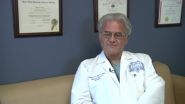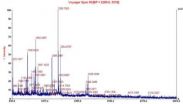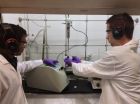(Press-News.org) Healthy men participating in the Prostate Cancer Prevention Trial who actively participate in all steps of the clinical trial are most likely to undergo a biopsy, according to a study published in Cancer Epidemiology, Biomarkers and Prevention – a journal of the American Association for Cancer Research.
The Prostate Cancer Prevention Trial was a randomized, double-blind, placebo-controlled trial which tested the efficacy of finasteride, a drug used for prostate cancer prevention. This study was conducted by SWOG – a cancer research cooperative group that designs and conducts multidisciplinary clinical trials.
Researchers at The University of Texas MD Anderson Cancer Center and the Fred Hutchinson Cancer Research Center used a systematic model to identify factors associated with men adhering to the end-of-study (EOS) biopsy requirement of the trial. The EOS biopsy, an invasive procedure that examines the cells or tissues of the prostate gland to determine if cancer is evident, is an important part of the study.
"Our study is unique because it evaluated factors prospectively associated with an invasive biopsy for a cancer prevention trial, not a cancer treatment trial," said Ellen R. Gritz, Ph.D., chair of Behavioral Science at MD Anderson, and lead author on the study.
The prevention trial was coordinated by SWOG at 219 sites involving more than 18,000 men. Participants were randomized into one of two groups; those administered finasteride and those given a placebo. Participants received educational materials about the study and biopsy procedures and were asked to attend regularly scheduled appointments throughout the trial.
Funded by the National Cancer Institute, scientists analyzed healthy men over a seven-year period to identify which factors at the six-year study mark were associated with the willingness of the participant to undergo a biopsy. The factors examined included psychosocial outcomes, participant health status, participant adherence, and characteristics of the clinical sites at which the study was conducted.
"The biopsy provided the biological specimens that could be tested to see if a man's prostate cells were cancer-free after seven years on the trial," said Carol Moinpour, Ph.D., of the Fred Hutchinson Cancer Research Center. "That is, the biopsy provided definitive information about which men had prostate cancer seven years after the study started."
Researchers were able to assess factors associated with adherence for more than 13,000 men from the trial, and analyzed factors based on whether or not study participants had been prompted for a clinical biopsy by year six of the study.
Researchers found participants were more likely to adhere to the EOS biopsy if one year prior to the biopsy they were adherent to the study drug, kept appointments and underwent required tests and were in good health. Participants who had an EOS biopsy were more likely to be adherent to the study drug at year six – 84 percent. Among participants who were not biopsied, only 47 percent were adherent to the study drug. Results also showed that 98 percent of men who had an EOS biopsy had the DRE (digital rectal exam) or PSA test done at year six, compared to 75 percent of men who did not have the EOS biopsy.
"We also found that participants were more likely to adhere to biopsies if the study site that recruited the participant enrolled more than 200 participants and/or had resources for conducting activities to encourage continued participation in the trial," said Gritz.
Researchers said monitoring adherence behaviors in clinical trial participants can help identify participants at risk for noncompliance to a study requirement, and help create a model for adherence intervention strategies in future trials.
"If we are able to determine which factors are associated with good adherence to study regimens evaluating cancer prevention agents, we may be able to improve the conduct of such large trials by targeting interventions to boost adherence," said Gritz.
INFORMATION:
The research was supported by the Public Service Health (CA37429) from the Department of Cancer Prevention, National Cancer Institute (NCI), NIH, Department of Health and Human Services. Lead author supported in part by funding from NCI (P30CA16672).
Other authors on the study include Kathryn Arnold, Carol Moinpour, Ph.D., Catherine Tangen, Dr.P.H., Phyllis Goodman and Shannon Hill, all of the Fred Hutchinson Cancer Research Center and the SWOG Statistical Center (all except Moinpour and Hill); Allison Burton-Chase, Ph.D., of Albany College of Pharmacy and Health Sciences; Jeffrey Probstfield, M.D., of UW Medicine; William See, M.D., of the Medical College of Wisconsin; Michael Lieber, M.D., of Mayo Clinic; Vincent Caggiano, M.D., of Sutter Medical Center; Sarah Moody-Thomas, Ph.D., of Louisiana State University Health Sciences Center; Connie Szczepanek, of Grand Rapids Clinical Oncology Program; Anne Ryan, of the National Cancer Institute; Susie Carlin, of C3 Research Associates; Rose Mary Padberg, of Arlington Free Clinic; Lori Minasian, M.D., of the National Cancer Institute; Frank Meyskens, M.D., of UC Irvine and Ian Thompson, Jr. M.D., of UT Health Science Center at San Antonio.
Prostate Cancer Prevention Trial identifies men mostly likely to undergo challenging study procedure
End of study biopsy adherence more common in healthy men actively engaged throughout trial
2014-08-13
ELSE PRESS RELEASES FROM THIS DATE:
With advances in HIV care, survivors face other disease risks
2014-08-13
August 13, 2014 – As effective treatments for HIV become more widely available in low- and middle-income countries, there's an urgent need to assess and manage health risks in the growing number of people living with HIV. An update on non-communicable diseases (NCDs) among HIV-positive populations in LMICs appears as a supplement to in JAIDS: Journal of Acquired Immune Deficiency Syndromes. The journal is published by Lippincott Williams & Wilkins, a part of Wolters Kluwer Health.
In an introductory article, Dr K.M. Venkat Narayan of Rollins School of Public Health, ...
Bacteria growing less susceptible to common antiseptic
2014-08-13
CHICAGO (August 13, 2014) – Bacteria that cause life-threatening bloodstream infections in critically ill patients may be growing increasingly resistant to a common hospital antiseptic, according to a recent study led by investigators at Johns Hopkins. The study was published in the September issue of Infection Control and Hospital Epidemiology, the journal of the Society for Healthcare Epidemiology of America.
Chlorhexidine gluconate (CHG) has been increasingly used in hospitals in light of recent evidence that daily antiseptic baths for patients in intensive care units ...
Care facility choice after hospital discharge about more than location, location, location
2014-08-13
INDIANAPOLIS -- Twenty-first-century patients typically don't stay in the hospital until they are completely well or totally healed. As hospitalization durations decrease, a significant number of older patients -- about one in five -- are discharged to skilled nursing facilities for continuation or closure of their care.
Deciding on the right post-discharge rehabilitation destination is important to future health and quality of life. However, it is a decision for which many patients and families are unprepared and unsupported, according to scientists from the Indiana ...
MRSA colonization common in groin and rectal areas
2014-08-13
CHICAGO (August 13, 2014) – Colonization of methicillin-resistant Staphylococcus aureus (MRSA) allows people in the community to unknowingly harbor and spread this life-threatening bacteria. The inside of the front of the nose is where this bacteria is most predominant, but new research shows nearly all colonized individuals have this bacteria living in other body sites. The study was published in Infection Control and Hospital Epidemiology, the journal of the Society for Healthcare Epidemiology of America.
"While people colonized with MRSA may not be sick, the bacteria ...
Henry Ford Hospital replaces heart valve outside the heart
2014-08-13
VIDEO:
Henry Ford Hospital cardiologist William O'Neill, M.D., Medical Director for the Henry Ford Center for Structural Heart Disease discusses the non-surgical procedure -- the first in the United States --...
Click here for more information.
DETROIT – For the first time in the United States, doctors at Henry Ford Hospital used a minimally invasive procedure to replace a failing, hard-to-reach heart valve with a new one – and placed it just outside the heart.
Due to prior ...
Morphological changes of GnRHR neurons in the rat preoptic area across puberty
2014-08-13
Gonadotropin-releasing hormone (GnRH) neurons in the preoptic area may undergo morphological changes during the pubertal period when their activities are upregulated. To clarify the regulatory mechanism of puberty onset, Dr. Quan Liu and co-workers from the First Hospital of Jilin University, China investigated the morphological changes of GnRH neurons in the preoptic area of GnRH-enhanced green fuorescent protein transgenic rats. Under confocal laser microscopy, pubertal GnRH neurons exhibited an inverted Y distribution pattern. Prepubertal GnRH neurons were generally ...
Treating Alzheimer's disease with Yizhijiannao granules by inhibiting neuronal apoptosis
2014-08-13
Previous studies have shown that Yizhijiannao granule can enhance cognitive performance in Alzheimer's disease patients and Alzheimer's disease-model mice. Further studies revealed that Yizhijiannao granule may exert its therapeutic effect by inhibiting neural cell apoptosis, reducing tau phos-phorylation and relieving neuroinflammation. Dr. Hong Zhu and colleagues who come from Third Xiangya Hospital of Central South University, China treated senescence-accelerated mouse prone 8 mice with Yizhijiannao granule, aiming to identify target-proteins of Yizhijiannao granule ...
Stem cell therapy for central nerve system injuries: Glial cells hold the key
2014-08-13
Mammalian adult central nerve system (CNS) injuries are devastating because of the intrinsic difficulties for effective neuronal regeneration. The greatest problem to be overcome for CNS recovery is the poor regeneration of neurons and myelin-forming cells, oligodendrocytes. Endogenous neural progenitors and transplanted exogenous neuronal stem cells can be the source for neuronal regeneration. However, because of the harsh local microenvironment, they usually have very low efficacy for functional neural regeneration which cannot compensate for the loss of neurons and oligodendrocytes. ...
Eco-friendly 'pre-fab nanoparticles' could revolutionize nano manufacturing
2014-08-13
AMHERST, Mass. – A team of materials chemists, polymer scientists, device physicists and others at the University of Massachusetts Amherst today report a breakthrough technique for controlling molecular assembly of nanoparticles over multiple length scales that should allow faster, cheaper, more ecologically friendly manufacture of organic photovoltaics and other electronic devices. Details are in the current issue of Nano Letters.
Lead investigator, chemist Dhandapani Venkataraman, points out that the new techniques successfully address two major goals for device manufacture: ...
What are the advantages of being married to a physician?
2014-08-13
ANN ARBOR, Mich. – Physicians tend to marry later and their marriages last longer even as they face the challenges, like others with demanding professions, of giving time and attention to their partners and families.
The University of Michigan Medical School interviewed physicians and spouses to learn how "medical marriages" succeed and the resulting report is rich with data and anecdotes about live-in in-laws, role definition, financial security and the advantage of avoiding the emergency room because Mom or Dad knows how to stitch a bad cut.
Published by the Association ...
LAST 30 PRESS RELEASES:
Making lighter work of calculating fluid and heat flow
Normalizing blood sugar can halve heart attack risk
Lowering blood sugar cuts heart attack risk in people with prediabetes
Study links genetic variants to risk of blinding eye disease in premature infants
Non-opioid ‘pain sponge’ therapy halts cartilage degeneration and relieves chronic pain
AI can pick up cultural values by mimicking how kids learn
China’s ecological redlines offer fast track to 30 x 30 global conservation goal
Invisible indoor threats: emerging household contaminants and their growing risks to human health
Adding antibody treatment to chemo boosts outcomes for children with rare cancer
Germline pathogenic variants among women without a history of breast cancer
Tanning beds triple melanoma risk, potentially causing broad DNA damage
Unique bond identified as key to viral infection speed
Indoor tanning makes youthful skin much older on a genetic level
Mouse model sheds new light on the causes and potential solutions to human GI problems linked to muscular dystrophy
The Journal of Nuclear Medicine ahead-of-print tip sheet: December 12, 2025
Smarter tools for peering into the microscopic world
Applications open for funding to conduct research in the Kinsey Institute archives
Global measure underestimates the severity of food insecurity
Child survivors of critical illness are missing out on timely follow up care
Risk-based vs annual breast cancer screening / the WISDOM randomized clinical trial
University of Toronto launches Electric Vehicle Innovation Ontario to accelerate advanced EV technologies and build Canada’s innovation advantage
Early relapse predicts poor outcomes in aggressive blood cancer
American College of Lifestyle Medicine applauds two CMS models aligned with lifestyle medicine practice and reimbursement
Clinical trial finds cannabis use not a barrier to quitting nicotine vaping
Supplemental nutrition assistance program policies and food insecurity
Switching immune cells to “night mode” could limit damage after a heart attack, study suggests
URI-based Global RIghts Project report spotlights continued troubling trends in worldwide inhumane treatment
Neutrophils are less aggressive at night, explaining why nighttime heart attacks cause less damage than daytime events
Menopausal hormone therapy may not pose breast cancer risk for women with BRCA mutations
Mobile health tool may improve quality of life for adolescent and young adult breast cancer survivors
[Press-News.org] Prostate Cancer Prevention Trial identifies men mostly likely to undergo challenging study procedureEnd of study biopsy adherence more common in healthy men actively engaged throughout trial






